Like any forest, the Eldorado and Stanislaus forests have a wide variety of wildlife and poisonous plants. While some wildlife and plants can be dangerous if you are not aware of them, with a little bit of awareness, you should have a safe, fun visit in the forests.
While most visitors are aware of Bears and Mountain Lions, many are unaware of the presence of snakes. The Northern Pacific Rattlesnake, incorrectly referred to as the Timber Rattler, is the most dangerous.
Once just an East Coast threat, populations of the “Deer Tick” are growing out West, and that includes the Mokelumne Recreation Area.
Hornets and Wasps deserve a high level of awareness, and mosquitoes and other small bugs make their home here as well.
And, while it doesn’t bite, Poison Oak’s effects can be severe. It can be found throughout the area.
The first step in protecting yourself is to know what to look for and what to do in order to avoid unwanted contact with these less than desirable guests.
 Bears, Mountain Lions and Bobcats: As none of the campgrounds have “bear proof garbage containers”, here are a few accepted practices. For large animals like bears, mountain lions and bobcats, never keep food outside, and that includes leftovers and garbage. While you can hang it from a tree, that doesn’t keep them from coming into your camp for a sniff. The simplest way for most visitors is to keep food sealed and locked, and then keep it in your car (the trunk if you have one) when you’re not eating. See more information about Bears, Bobcats & Mountain Lions.
Bears, Mountain Lions and Bobcats: As none of the campgrounds have “bear proof garbage containers”, here are a few accepted practices. For large animals like bears, mountain lions and bobcats, never keep food outside, and that includes leftovers and garbage. While you can hang it from a tree, that doesn’t keep them from coming into your camp for a sniff. The simplest way for most visitors is to keep food sealed and locked, and then keep it in your car (the trunk if you have one) when you’re not eating. See more information about Bears, Bobcats & Mountain Lions. Rattlesnakes & Vipers: While generally clear of campgrounds, you should always be on the lookout for snakes, and that includes in the water. The area has a significant population of Rattlesnakes. The Northern Pacific Rattlesnake can exceed 3′ in length, the longest recorded over 5′. As these rattlesnakes mature, their color changes, nearing the ground color they habitat. This can make them difficult to see. Always be aware of composting vegetation, never step over a log without looking and always keep your eyes on the ground. If you plan on hiking, a set of snake chaps can be a good investment.
Rattlesnakes & Vipers: While generally clear of campgrounds, you should always be on the lookout for snakes, and that includes in the water. The area has a significant population of Rattlesnakes. The Northern Pacific Rattlesnake can exceed 3′ in length, the longest recorded over 5′. As these rattlesnakes mature, their color changes, nearing the ground color they habitat. This can make them difficult to see. Always be aware of composting vegetation, never step over a log without looking and always keep your eyes on the ground. If you plan on hiking, a set of snake chaps can be a good investment. Deer Tick: Once only believed to be of concern in the Northeast, the deer tick population has been steadily increasing in the West, and the Sierra Nevadas have become its habitat as well. This new strain of the deer tick, the Western Black Legged Tick, has all of the dangers of the Eastern Black Legged Tick, mainly it also carries and spreads Lyme Disease. If you think that if you are infected you will see a “bulls eye” around the bite area, this diagnosis has proven unreliable. Be aware when walking under trees as the deer tick sense heat. Wear long sleeve shirts and log pants and tuck your pants into your socks. Apply DEET repellent. Upon return, check yourself for ticks and take a shower if you have one available. This is only a partial list. Please see the following information from the CDC and others.
Deer Tick: Once only believed to be of concern in the Northeast, the deer tick population has been steadily increasing in the West, and the Sierra Nevadas have become its habitat as well. This new strain of the deer tick, the Western Black Legged Tick, has all of the dangers of the Eastern Black Legged Tick, mainly it also carries and spreads Lyme Disease. If you think that if you are infected you will see a “bulls eye” around the bite area, this diagnosis has proven unreliable. Be aware when walking under trees as the deer tick sense heat. Wear long sleeve shirts and log pants and tuck your pants into your socks. Apply DEET repellent. Upon return, check yourself for ticks and take a shower if you have one available. This is only a partial list. Please see the following information from the CDC and others.